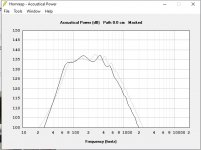No idea about the RCF drivers, but don´t think these wave guides are critical.
I would use 15NW76, because one can build pretty small enclosure, something like 90-100l for two drivers.
Regarding US company making horns.
DDS horns have a single 15" horn which looks like the perfect fit: DVB 15N.
But you guys realize, that we are talking about american fridge sized speakers Meyer Sound would be proud of
Has anyone had any luck contacting DDS? Ive tried several times over the last year and got no answer, windering if they went under with the pandemic?
Sent from my iPhone

